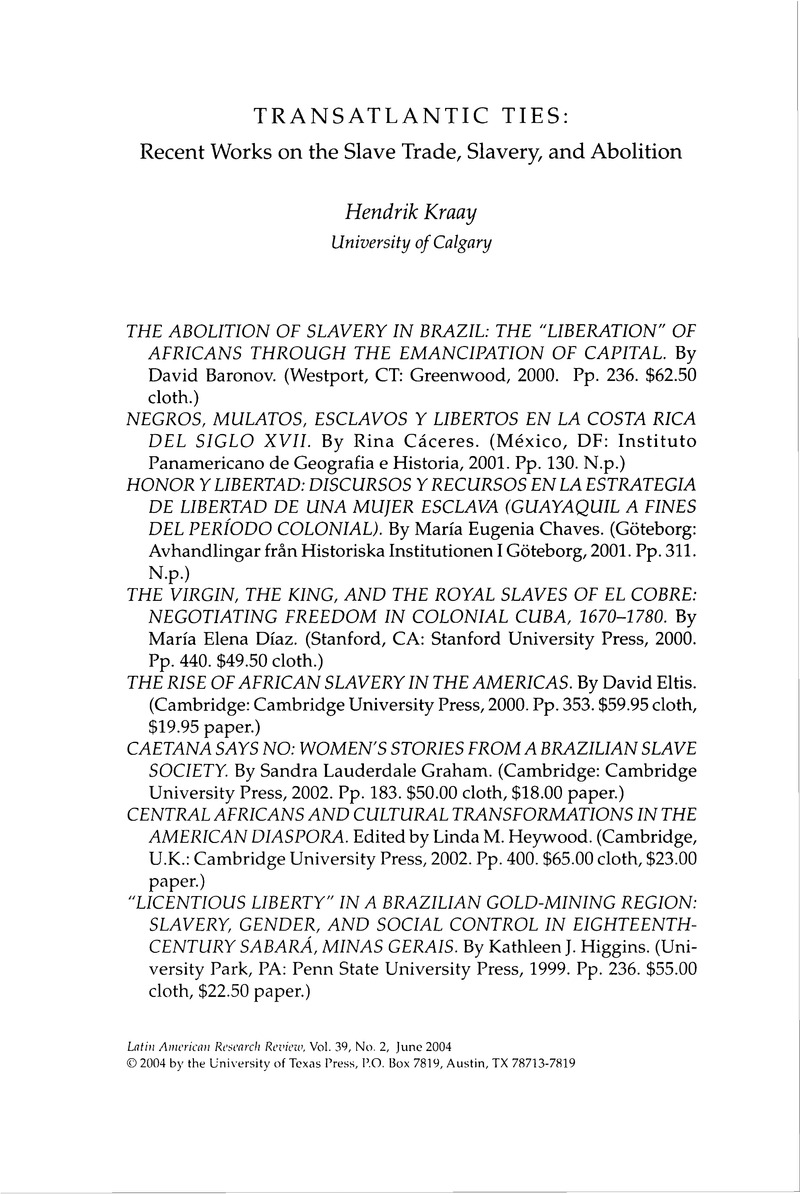No CrossRef data available.
Article contents
Transatlantic Ties: Recent Works on the Slave Trade, Slavery, and Abolition
Review products
Published online by Cambridge University Press: 05 October 2022
Abstract

- Type
- Review Essays
- Information
- Copyright
- Copyright © 2004 by the University of Texas Press
References
1. David Eltis, Stephen D. Behrendt, David Richardson, and Herbert S. Klein, The Transatlantic Slave Trade, 1562-1847: A Database on CD-Rom (Cambridge, MA: Cambridge University Press, 1998).
2. Interestingly, Mahommah Gardo Baquaqua, another West African who left an account of his journey, also experienced a relatively easy passage to the coast some seventy-five years after Equiano. See The Biography of Mahommah Gardo Baquaqua: His Passage from Slavery to Freedom in Africa and America, ed. Robin Law and Paul E. Lovejoy (Princeton: Markus Wiener, 2001), 136-48.
3. Joseph C. Miller, Way of Death: Merchant Capitalism and the Angolan Slave Trade, 1730-1830 (Madison: University of Wisconsin Press, 1988).
4. See Sienes, Na senzala, uma flor, 200-201 (reviewed in this essay).
5. John K. Thornton, Africa and Africans in the Making of the Atlantic World (Cambridge, MA: Cambridge University Press, 1992).
6. See Joseph E. Inikori's lengthy reviews of Eltis, American Historical Review 106, no. 5 (December 2001): 1751-53; and Klein, Hispanic American Historical Review 82, no. 1 (February 2002): 130-35.
7. For a more detailed examination of a similar community in Mexico, see Ben Vinson III, Bearing Anns for His Majesty: The Free-Colored Militia in Colonial Mexico (Stanford, CA: Stanford University Press, 2001), 190-98.
8. Heywood's book can be read as a companion volume to the collections of essays produced by scholars associated with the UNESCO-sponsored Nigerian Hinterland Project at York University in Toronto, now part of the Harriet Tubman Resource Centre on the African Diaspora (http://www.yorku.ca/nhp), which focus primarily on West Africans. See, for example, Paul E. Lovejoy, ed., Identity in the Shadow of Slavery (London: Continuum, 2000) and Kristin Mann and Edna G. Bay, Rethinking the African Diaspora: The Making of a Black Atlantic World in the Bight of Benin and Brazil (London: Frank Cass, 2001).
9. Paul E. Lovejoy, “Identifying Enslaved Africans in the African Diaspora,” in Identity, ed. idem., 12.
10. This book is a companion volume to Soares's A negregada instituição: As capoeiras na Corte imperial, 1850-1890 (Rio de Janeiro: Access, 1999).
11. For suggestive comments on the importance of urban centers in African-American culture, see Philip D. Morgan, “The Cultural Implications of the Atlantic Slave Trade: African Regional Origins, American Destinations and New World Developments,” Slavery and Abolition 18, no. 1 (April 1997): 140-41.
12. Two recent English-language works, among many others, serve as useful introductions to these questions: George Reid Andrews, Blacks and Whites in São Paulo, Brazil, 1888-1988 (Madison: University of Wisconsin Press, 1991); Kim D. Butler, Freedoms Given, Freedoms Won: Afro-Brazilians in Post-Abolition São Paulo and Salvador (New Brunswick: Rutgers University Press, 1998).
13. Stuart B. Schwartz, Slaves, Peasants, and Rebels: Reconsidering Brazilian Slavery (Urbana: University of Illinois Press, 1992), 39.


